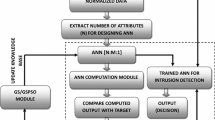Abstract
An Intrusion Detection System (IDS) is a program that analyzes what happens or has happened during an execution and tries to find indications that the computer has been misused. An IDS does not eliminate the use of preventive mechanism but it works as the last defensive mechanism in securing the system. This paper evaluates the performances of Multi-Expression Programming (MEP) to detect intrusions in a network. Results are then compared with Linear Genetic Programming (LGP) approach. Empirical results clearly show that genetic programming could play an important role in designing light weight, real time intrusion detection systems.
Preview
Unable to display preview. Download preview PDF.
Similar content being viewed by others
References
Abraham, A.: Evolutionary Computation in Intelligent Web Management, Evolutionary Computing in Data Mining. In: Ghosh, A., Jain, L.C. (eds.) Studies in Fuzziness and Soft Computing, ch. 8, pp. 189–210. Springer, Heidelberg (2004)
Barbara, D., Couto, J., Jajodia, S., Wu, N.: ADAM: A Testbed for Exploring the Use of Data Mining in Intrusion Detection. SIGMOD Record 30(4), 15–24 (2001)
Brameier, M., Banzhaf, W.: A comparison of linear genetic programming and neural networks in medical data mining. IEEE Transactions on Evolutionary Computation 5(1), 17–26 (2001)
Brameier, M., Banzhaf, W.: Explicit control of diversity and effective variation distance in Linear Genetic Programming. In: Miller, J., Tomassini, M., Lanzi, P.L., Ryan, C., Tetamanzi, A.G.B., Langdon, W.B. (eds.) EuroGP 2001. LNCS, vol. 2038, Springer, Heidelberg (2001)
Brieman, L., Friedman, J., Olshen, R., Stone, C.: Classification of Regression Trees. Wadsworth Inc. (1984)
Cohen, W.: Learning Trees and Rules with Set-Valued Features. In: American Association for Artificial Intelligence, AAAI, Menlo Park (1996)
Denning, D.: An Intrusion-Detection Model. IEEE Transactions on Software Engineering SE-13(2), 222–232 (1987)
KDD Cup (1999), Intrusion detection data set: http://kdd.ics.uci.edu/databases/kddcup99/kddcup.data_10_percent.gz
Lee, W., Stolfo, S., Mok, K.: A Data Mining Framework for Building Intrusion Detection Models. In: Proceedings of the IEEE Symposium on Security and Privacy (1999)
MIT Lincoln Laboratory, http://www.ll.mit.edu/IST/ideval/
Oltean, M., Grosan, C.: A Comparison of Several Linear GP Techniques. Complex Systems 14(4), 285–313 (2004)
Oltean, M., Grosan, C.: Evolving Evolutionary Algorithms using Multi Expression Programming. In: Proceedings of The 7th European Conference on Artificial Life, Dortmund, Germany, pp. 651–658 (2003)
Peddabachigari, S., Abraham, A., Thomas, J.: Intrusion Detection Systems Using Decision Trees and Support Vector Machines. International Journal of Applied Science and Computations 11(3), 118–134 (2004)
Ryan, C., et al.: Gramatical Evolution:Evolving programs for an arbitrary language. In: Proceedings of the first European Workshop on Genetic Programming, Springer, Berlin (1998)
Summers, R.C.: Secure Computing: Threats and Safeguards. McGraw Hill, New York (1997)
Vapnik, V.N.: The Nature of Statistical Learning Theory. Springer, Heidelberg (1995)
Author information
Authors and Affiliations
Editor information
Editors and Affiliations
Rights and permissions
Copyright information
© 2005 Springer-Verlag Berlin Heidelberg
About this paper
Cite this paper
Groşan, C., Abraham, A., Han, a.S.Y. (2005). MEPIDS: Multi-Expression Programming for Intrusion Detection System. In: Mira, J., Álvarez, J.R. (eds) Artificial Intelligence and Knowledge Engineering Applications: A Bioinspired Approach. IWINAC 2005. Lecture Notes in Computer Science, vol 3562. Springer, Berlin, Heidelberg. https://doi.org/10.1007/11499305_17
Download citation
DOI: https://doi.org/10.1007/11499305_17
Publisher Name: Springer, Berlin, Heidelberg
Print ISBN: 978-3-540-26319-7
Online ISBN: 978-3-540-31673-2
eBook Packages: Computer ScienceComputer Science (R0)




